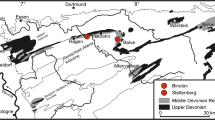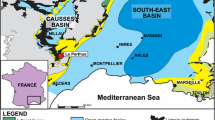Аbstract
The Varna microbial carbonate reefs, known as the ‘upright stones’, аrе limestone columns of natural origin, formed in the Eocene sands near the town of Varna, NE Bulgaria. These unique geological formations are among the most impressive natural phenomena in Bulgaria and lie in a protected area of 253.3 hectares which includes 18 geosites of aesthetic and scientific value. Some of these features forme part of the ‘Golden Sands’ Natural Park. The upright stones are bacterial-algal reefs formed within non-carbonate Ypresian sands and silts of the Dikilitash Formation. They are of geomorphological, sedimentological and paleontological interest. Human interest in the columns is a result of their unique morphology, due to which they were originally considered to be the remains of ancient temples and castles. According to various theories, these are weathering or infiltration formations, concretions, coral reefs, petrified forests, etc. At the end of the twentieth century, their genesis was studied in the context of a phytogenetic origin, and it was concluded that they are bacterial-algal bioherms similar to recent atolls and miniatols in modern oceans and seas. In support of this hypothesis is the presence of microbial stromatolite laminations and structures, tubular bodies and algal remains in the columns that are not found in the sediments outside of the columns. The Varna reefs are an attractive tourist destination for visitors of the Bulgarian Black Sea coast. These are included in the UNESCO Programme for the protection of geological heritage of scientific value. The future of these unique geological formations depends on their protection at a national and a European level.













Similar content being viewed by others
References
Alajova-Hrischeva К (1990) Stratigraphy of the lower Eocene sediments in some of the East Bulgarian plateaus. Rev Bulg Geol Soc 60(1):21–31
Bakalov P (1921) Upright stones (Dikilitash) Varna District. Nature 22(1):4–6
Bakalov P (1922) The stone pillars—Varna district. Bulg Tour 4(3):37–39
Bonchev S (1934) The origin (genesis) of the “upright stones” (Dikilitash) or “stick ups” in Varna District. Geol Balk 1(1):5–15
Bonchev Е (1949) What we know about the origin of the “upright stones”. Nat Knowl 2(9–10):41–43
Bonchev Е (1955) The upright stones. Nature 3:29–31
Bonchev Е (1970) Origin of the upright stones. Nat Knowl 6–7:30–37
Botz R, Georgiev V, Stoffers P, Khrischev K, Kostadinov V (1993) Stable isotope study of carbonate-cemented rocks from the Pobitite Kamani area, North-Eastern Bulgaria. Geol Rundsch 82:663–666
Davitashvili L, Zakharieva-Коvacheva K (1963a) On the origin of the “stone forest” near Varna (Bulgaria). Bull Acad Sci Georgia SSR 30(2):441–446
Davitashvili L, Zakharieva-Коvacheva K (1963b) Enigma of the “stone forest” in Bulgaria. Nature 9:90–91
Davitashvili L, Zakharieva-Коvacheva К (1975) Origin of the “stone forests”. Metsniereba Тbilisi, pp 196
De Boever E, Swennen R, Dimitrov L (2006) Lower Eocene cemented chimneys (Varna, NE Bulgaria): formation mechanisms and the (a)biological mediation of chimney growth? Sediment Geol 185:159–173
De Boever E, Huysmans M, Swennen R, Muchez P, Dimitrov L (2008a) Controlling factors on the morphology and spatial distribution of hydrocarbon-related tubular concretions—study of a Lower Eocene seep system. Mar Pet Geol. doi:10.1016/j.marpetgeo.2008.1011.1004
De Boever E, Dimitrov L, Muchez P, Swennen R (2008b) The Pobiti Kamani area (Varna, NE Bulgaria)—study of a well-preserved paleo-seep system. Rev Bulg Geol Soc 69(1–3):61–68
De Boever E, Birgel D, Thiel V, Muchez P, Peckmann J, Dimitrov L, Swennen R (2009) The formation of giant tubular concretions triggered by anaerobic oxidation of methane as revealed by archaeal molecular fossils (Lower Eocene, Varna, Bulgaria). Palaeogeogr Palaeoclimatol Palaeoecol 280(1–2):23–36
Doyle P, Bennett MR (1998) Earth heritage conservation: past, present and future agendas. In: Bennett MR, Doyle P (eds) Issues in environmental geology: a British perspective. Geological Society, London, pp 41–67
Ehrenberg K (1938) Gedanken zur Entstehung des Dikili Tasch. Wiss Jahrb Erst Donau-Dampf schif Ges 1 Wien: 97–107
Gellert I (1929) Die Neogenbucht von Varna und ihre Umrandung. Balkanforsch Geol Inst Univ Leipzig VII Abh math phys Kl Sachs Ak Wiss 41(2): pp 91.
Gellert I (1932) Die eigenartigen Verwitterunge und Landschefts—formen des Dikilitasch. Sandsteines in Nordost Bulgarien. Geol Rdsch 23(3–4):173–178
Gochev P (1933) Paleontological and stratigraphical investigations on the Eocene in Varna Region. Rev Bulg Geol Soc 5(1):1–83
Gray M (2004) Geodiversity, valuing and conserving abiotic nature. John Wiley & Sons
Haage R (1968) Zur Petrologie der Kalksandsteinbildungen, genannt “Pobitite Kamani”, bei Varna (VR Bulgarien). Geologie 17(4):411–417
Hose TA (2012) 3G’s for Modern Geotourism. Geoheritage 4(1–2):7–24
Kauffman E, Elder W, Sageman B (1991) High-resolution correlation: a new tool in chronostratigraphy. In: Einsele G, Ricken W, Seilacher A (eds) Cycles and events in stratigraphy”. Springer, Berlin Heidelberg New York, pp 795–819
Kidwell S, Jablonski D (1983) Taphonomic feedback: ecological consequences of shell accumulation. In: Tevesz M J S, McCall P L (Eds.) Biotic interactions in recent and fossil benthic communities. Topic Geobiol 3 Plenum New York, pp 195–248
Lahn E (1934) Der “Steinerne Wald” von Varna (Ostbulgarien). Zentralblatt Min Geol Paleont Abt. B:391–394
Magagna A, Ferrero E, Giardino M, Lozar F, Perotti L (2013) A selection of geological tours for promoting the Italian geological heritage in the secondary schools. Geoheritage 5(4):265–273
Margos A (1960) The wonderful stone forest. State Publishing House, Varna, p 39
Nachev I, Nachev C (2001a) “The upright stones”—bacterial-algal columns. Rev Geol Miner Resour 8(4):68–71
Nachev I, Nachev C (2001b) “The upright stones”—bacterial-algal columns. Sofia, pp 110
Nachev I, Маndev S, Zhelev K (1986a) The upright stones—algal bioherms. Rev Bulg Geol Soc 47(3):1–13
Nachev I, Маndev S, Zhelev К (1986b) New hypothesis about the origin of the upright stones. Nature 35(6):15–21
Newsome D, Dowling R (2006) The scope and nature of geotourism. In: Dowling R, Newsome D (Eds.) “Geotourism”. Elsevier, pp 3–25
Pamoukchiev А (1996) Reef-building organisms and organogenic builds from Bulgaria, Algeria, Tunisia and Zair, (Late Proterozoic, Cretaceous, Paleogene). Autoref doct disert, Sofia University, 50 p
Panos V, Skacel J (1966) Zur Frage der Entstehung der Steinsaulen (“Pobitite Kameni”) und anderer eigenartiger Formen zwischen Varna und Beloslav in Nordost-Bulgarien. Zeitschr Geomorphologie N F 10(2):105–118
Popov V (1957) Wonderful places of our country. Sofia Technika pp 52–65
Popov V (1963) Upright stones Dikilitash. In: Our preserves and natural landmarks. Sofia
Popov V (1984) Genesis of the “upright stones”. Nature 4:68–71
Radev V (1938) Secret of the “upright stones” in Varna region-revealed. J Today N638/17.03.1938
Radev V (1939) The Dikilitash columns of biogenic point of view. Ann Sofia Univ Phys-Math Fac Nat Hist 35(3):201–224
Riding R (2000) Microbial carbonates: the geological record of calcified bacterial-algal mats and biofilms. Sedimentology 47:179–214
Shkorpil G, Shkorpil K (1921) Twenty years activity of the Varna Archaeological Society, 1901–1921. Proc Arhaeol Soc 7:3–84
Sinnyovska D, Sinnyovsky D (2011) Museum exposure of rocks and fossils from the geological phenomenon “upright stones”, Varna district. Ann Univ Min Geol 54:56–61
Skacel J (1963) Ke vzniku sloupovitych tvaru “Pobiti kamni” u Varny v Bulgarsku. Zpravy Slozskeho Ustavu CSAV v Oprave Prirodni ved 128-B:1–12
Spratt T (1856) On the geology of Varna and its vicinity, and of other parts of Bulgaria. Q J Geol Soc Lond Proc Geol Soc 12(1):387–388
Spratt T (1857) On the geology of Varna and the neighbouring parts of Bulgaria. Q J Geol Soc Lond Proc Geol Soc 13(1):72–73
Teplyakov V (1833) Letters from Bulgaria. Moscow, pp 104–112
Toula F (1892) Geologische Untersuchungen im Ostlich Balkan. Denkschr Ak Wiss Wien Mat-Nat Kl 59(2):409–478
Ulbrich H (1939) Ein “Steinerer Wald”. Kosmos H I Stuttgart
Zakharieva-Kovacheva K (1969) Again about “stone forest” (Dikilitash) in the surroundings of Varna. Rev Bulg Geol Soc 30(3):365–368
Author information
Authors and Affiliations
Corresponding author
Rights and permissions
About this article
Cite this article
Nachev, I., Sinnyovsky, D. Eocene Varna Reefs in NE Bulgaria. Geoheritage 6, 271–282 (2014). https://doi.org/10.1007/s12371-014-0120-1
Received:
Accepted:
Published:
Issue Date:
DOI: https://doi.org/10.1007/s12371-014-0120-1




